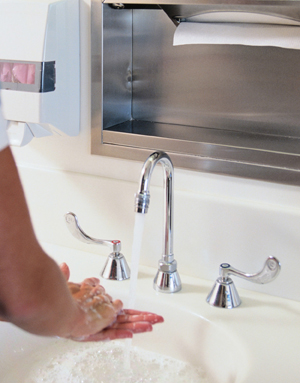Preventing the Spread of Infection
Preventing the Spread of Infection
Certain infections can spread from person to person. This is why your friend or family member may be put in a special room while in the hospital. Restrictions may be placed on who can go in and out of that room and what protection must be worn. Read this sheet to better understand why this is done.
Practice good hand hygiene to help stop the spread of germs.
How infection spreads
Infection is caused by germs. An infected person carries germs that he or she can give to others. Even a person who doesn’t feel sick can still carry and spread germs. Germs can cause infection by traveling through the air or through direct contact or when each of you touch the same surface in a room such as a doorknob, sink faucet, tabletop or chair.
How you can become infected
To infect you, germs first have to get inside your body. You can get infected by touching a contaminated person or object. You can also get infected by breathing contaminated air. This is why good hand hygiene and other infection control recommendations, like wearing a mask, are so important. Hand hygiene refers to handwashing with soap and water or the use of alcohol-based gels or foams that do not need using water.
Preventing infection
To stop infection from spreading, healthcare workers may do one or more of the following:
Place an infected patient in a private room, or in a room with others who have exactly the same infection. (This depends on what kind of infection the patient has.)
Wear a mask, gloves, gown, or other items.
Wear a respirator (air filter) for some infections.
What you can do
Here’s how to help stop the spread of infection:
You may be asked to wear a mask, gloves, gown, or respirator when you visit. Follow any instructions carefully.
Practice good hand hygiene, especially after using the bathroom and before and after touching the patient or the patient surroundings.
Keep your hands away from your face.
Cough or sneeze only into a tissue.
Do not use the patient’s bathroom.
Do not visit a patient if you feel sick. Do not visit if you have been exposed to an illness such as the flu, chickenpox, or measles.
Updated:
March 20, 2017
Reviewed By:
Fetterman, Anne, RN, BSN,Lentnek, Arnold, MD
